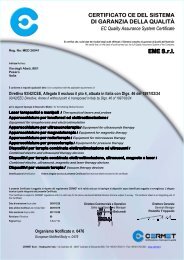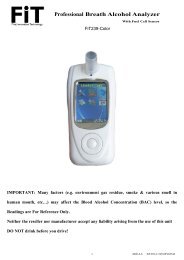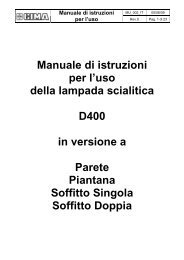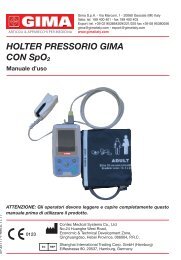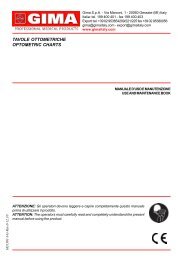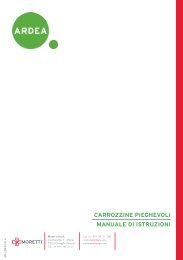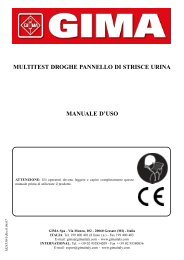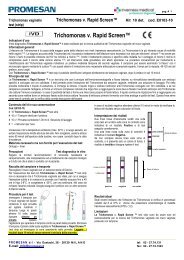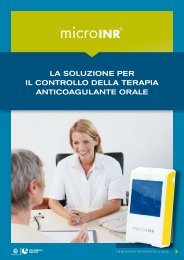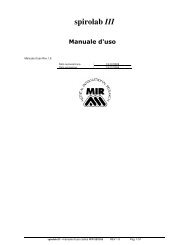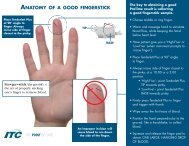Cryptosporidium parvum Card Test - Doctorshop.it
Cryptosporidium parvum Card Test - Doctorshop.it
Cryptosporidium parvum Card Test - Doctorshop.it
You also want an ePaper? Increase the reach of your titles
YUMPU automatically turns print PDFs into web optimized ePapers that Google loves.
IVD<br />
<strong>Cryptosporidium</strong> <strong>parvum</strong><br />
<strong>Card</strong> <strong>Test</strong><br />
Immunochromatographic test for<br />
<strong>Cryptosporidium</strong> <strong>parvum</strong><br />
detection in stool specimens<br />
1 2 3 4<br />
Simple<br />
Sens<strong>it</strong>ive<br />
Specific<br />
5<br />
-<br />
6<br />
+<br />
C<br />
T S<br />
C<br />
T S<br />
C<br />
T S<br />
Distributed by:<br />
Cer<strong>Test</strong><br />
BIOTEC, S.L.<br />
CEEI Aragón, nave 16. María de Luna 11.<br />
E-50018 Zaragoza - España - Spain<br />
Tel. +34 976 520354 - Fax +34 976 106268<br />
certest@certest.es - www.certest.es
CERTEST CRYPTO CARD<br />
One Step <strong>Cryptosporidium</strong> <strong>parvum</strong> <strong>Card</strong> test<br />
INTENDED USE<br />
The Cer<strong>Test</strong> Crypto <strong>Card</strong> is a one step coloured chromatographic immunoassay for the qual<strong>it</strong>ative<br />
detection of <strong>Cryptosporidium</strong> <strong>parvum</strong> in stool samples.<br />
INTRODUCTION<br />
<strong>Cryptosporidium</strong> <strong>parvum</strong> is the major cause of persistent diarrhoea in developing countries. This<br />
paras<strong>it</strong>e is recognised as a highly infectious enteric pathogen and infective stage is transm<strong>it</strong>ted by the<br />
fecal-oral route. Symptoms of cryptosporidiosis include watery diarrhoea, stomach cramps, weight loss,<br />
nausea and sometimes fever.<br />
INTERPRETATION OF RESULTS (please refer to the illustration below)<br />
GREEN<br />
RED<br />
RED<br />
PRINCIPLE OF THE TEST<br />
Cer<strong>Test</strong> Crypto <strong>Card</strong> uses a new one-step immunochromatographic system w<strong>it</strong>h coloured latex particles.<br />
It is a simple-to-use test which only needs the dilution of the fecal sample w<strong>it</strong>h the supplied ready-to-use<br />
dilution buffer.<br />
Specific<strong>it</strong>y is ensured by using mouse monoclonal antibodies directed against specific membrane<br />
antigens of <strong>Cryptosporidium</strong> <strong>parvum</strong>. These reagents are used conjugated w<strong>it</strong>h coloured latex particles<br />
and coated on a n<strong>it</strong>rocellulose membrane. Liquid sample and coloured latex particles conjugate both<br />
migrate by capillary action. Upon reaching the first specific anti-<strong>Cryptosporidium</strong> monoclonal reagent,<br />
any <strong>Cryptosporidium</strong> present in the sample will be blocked and an immunoreaction will appear as a red<br />
coloured line (result line). The sample continues to migrate up the test, on reaching the second reagent, a<br />
green coloured line (control line) is formed. This green line indicates that the sample has migrated<br />
correctly and that the chromatography has developed w<strong>it</strong>hout hindrance. The control line appears w<strong>it</strong>h<br />
both pos<strong>it</strong>ive and negative samples. If this line does not develop, the test is invalid. The presence of this<br />
green band serves as verification that sufficient volume is added, that proper flow is obtained and as an<br />
internal control for the reagents.<br />
STORAGE AND STABILITY<br />
Store as packaged in the sealed pouch at 2-30ºC. The test is stable through the expiration date printed on<br />
the sealed pouch. The test must remain in the sealed pouch until use. Do not freeze.<br />
NEGATIVE POSITIVE INVALID<br />
NEGATIVE: Only one GREEN band appears across the central window in the s<strong>it</strong>e marked w<strong>it</strong>h the<br />
letter C (control line).<br />
POSITIVE: In add<strong>it</strong>ion to the GREEN control band, a distinguishable RED band also appears in the s<strong>it</strong>e<br />
marked w<strong>it</strong>h the letter T (result line).<br />
INVALID: A total absence of the control coloured band (GREEN) regardless of the appearance or not<br />
of the result line (RED). Insufficient specimen volume or incorrect procedural techniques are the most<br />
likely reasons for control line failure. Review the procedure and repeat the tests w<strong>it</strong>h a new test. If the<br />
problem persists, discontinue using the test k<strong>it</strong> and contact you local distributor.<br />
NOTES ON THE INTERPRETATION OF RESULTS<br />
The intens<strong>it</strong>y of the red coloured band in the result line region (T) will vary depending on the<br />
concentration of antigen present in the specimen. However, ne<strong>it</strong>her the quant<strong>it</strong>ative value, nor the rate of<br />
increase in antigen can be determined by this qual<strong>it</strong>ative test.<br />
PRECAUTIONS<br />
QUALITY CONTROL<br />
- For professional in v<strong>it</strong>ro diagnostic use only. Internal procedural controls are included in the test. A green line appearing in the control region (C) is<br />
- Do not use after expiration date.<br />
the internal procedural control. It confirms sufficient specimen volume and correct procedural<br />
- All the specimens should be considered potentially hazardous and handled in the same manner as an<br />
technique.<br />
infectious agent.<br />
- The tests should be discarded in a proper biohazard container after testing.<br />
LIMITATIONS<br />
SPECIMEN COLLECTION AND PREPARATION<br />
Stool samples should be collected in clean containers and the assay should be done right after collection.<br />
The samples can be stored in the refrigerator (2-4 ºC) for 1-2 days prior to testing. For longer storage,<br />
maximum 1 year, the specimen must be kept frozen at –20ºC. In this case, the sample will be totally<br />
thawed, and brought to room temperature before testing.<br />
Specimen preparation (see illustration):<br />
- (1) Take out the top and add 1 mL (30 drops) of the sample diluent in the stool collection tube.<br />
- (2) Use the stick to pick up a l<strong>it</strong>tle sample. Close the tube w<strong>it</strong>h the diluent and stool sample. (3)<br />
Shake the tube in order to assure good sample dispersion.<br />
MATERIALS PROVIDED<br />
Stool sample<br />
1. The test must be carried out w<strong>it</strong>hin 2 hours of opening the sealed bag.<br />
2. An excess of stool sample could cause wrong results (brown bands appear). Dilute the sample w<strong>it</strong>h<br />
the buffer and repeat the test.<br />
3. After one week of infection, the number of paras<strong>it</strong>es in feces is decreasing, making the sample less<br />
reactive. Stool samples should be collected w<strong>it</strong>hin one week of the onset of symptoms.<br />
4. This test provides a presumptive diagnosis for Cryposporidiosis. A confirmed infection diagnosis<br />
should only be made by a physician after all clinical and laboratory findings have been evaluated.<br />
EXPECTED VALUES<br />
Add diluent<br />
PERFORMANCE<br />
(1 mL)<br />
Negative results are expected in healthy patients. This test is intended to be used for the diagnosis of<br />
criptosporidiosis only.<br />
Sens<strong>it</strong>iv<strong>it</strong>y<br />
The evaluation was conducted comparing the results obtained using the Cer<strong>Test</strong> Crypto <strong>Card</strong> to another<br />
commercial available ELISA C. <strong>parvum</strong> assay.<br />
The detection of C. <strong>parvum</strong> showed 95% of concordance w<strong>it</strong>h the commercial ELISA assay.<br />
Stool Collection<br />
Tube (1) (2) (3) Specific<strong>it</strong>y<br />
The use of mouse monoclonal antibodies in the elaboration of Cer<strong>Test</strong> Crypto <strong>Card</strong> assures <strong>it</strong>s high<br />
degree of specific<strong>it</strong>y for antigens of C. <strong>parvum</strong>.<br />
- Device tests REFERENCES<br />
- Sample diluent<br />
1. PENG M. M., XIAO L., FREEMAN A. R., “Genetic Polymorphism Among <strong>Cryptosporidium</strong><br />
- Instructions for use<br />
<strong>parvum</strong> Isolates. Evidence of Two Distinct Human Transmission Cycles”, Emerging Infectious<br />
- Stool collection tubes<br />
Diseases, Vol 3 No 4, Oct-Dec. 1997, pp 567-573<br />
MATERIALS REQUIRED BUT NO PROVIDED<br />
2. MARSHALL, M.M., et al., “Waterborne Protozoan Pathogens”, Clinical Microbiology Review, Jan.<br />
1997, pp 67-85<br />
- Specimen collection container 3. GUERRANT, R.L., “Cryptosporidiosis: An Emerging, Highly Infectious Threat”, Emerging<br />
- Disposable gloves<br />
Infectious Diseases, Vol 3 No 1, January-March 1997, pp 51-57<br />
- Timer 4. FAYER, R. and UNGAR, L.P., “<strong>Cryptosporidium</strong> spp. and Cryptosporidiosis”, Microbiological<br />
TEST PROCEDURE<br />
Reviews, Dec. 1986, Vol. 50, No. 4, pp. 458-483<br />
Allow the tests, stool samples and controls to reach to room temperature (15-30ºC) prior to<br />
testing. Do not open pouches until ready to perform the assay.<br />
1. Proceed to shake the stool collection tube in order to assure good sample dispersion. Cut the end of<br />
the top (4).<br />
2. Remove the Cer<strong>Test</strong> Crypto <strong>Card</strong> device from <strong>it</strong>s sealed bag just before using.<br />
3. Use a separate stool collection tube and device for each sample or control. Dispense exactly 5 drops<br />
or 150 µL into the circular window marked w<strong>it</strong>h an arrow, avoiding to add solid particles w<strong>it</strong>h the liquid<br />
(5).<br />
In case the tests did not run due to solid particles fallen into the round window, stir the sample added or<br />
dispense a drop of extraction buffer until seeing the liquid running through the reaction zone.<br />
4.- Read the result at 10 minutes (the coloured bands appear).<br />
SYMBOLS FOR IVD COMPONENTS AND REAGENTS<br />
In v<strong>it</strong>ro diagnostic<br />
device<br />
Consult instructions<br />
for use<br />
Keep dry<br />
Temperature lim<strong>it</strong>ation<br />
Use by<br />
Batch code<br />
Catalogue number<br />
Contains sufficient for<br />
tests<br />
Manufacturer<br />
Do not use if package<br />
damaged<br />
Crypto <strong>Card</strong><br />
S<br />
Add 5 drops<br />
Cer<strong>Test</strong><br />
BIOTEC<br />
February 2005. Revision: 02<br />
María de Luna 11<br />
E-50018 Zaragoza (SPAIN)<br />
www.certest.es<br />
Control region Result region<br />
(4) (5)



